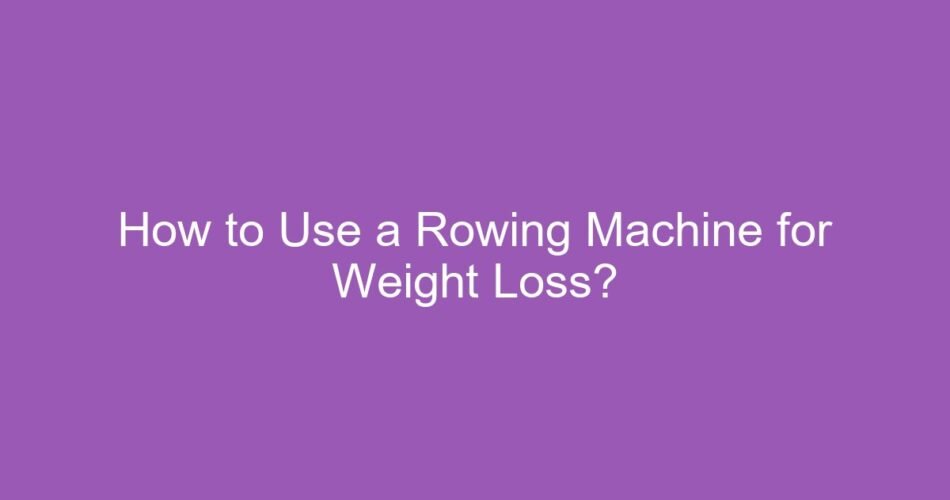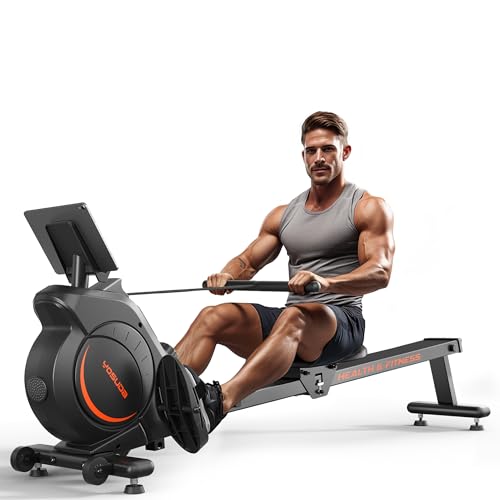Achieving significant calorie burn and driving metabolism is the key to weight loss. Discover how to use a rowing machine for weight loss? We outline the essential technique, optimal workout schedules, and metabolic strategy.
How to Use a Rowing Machine for Weight Loss? success hinges on integrating the rowing machine into a weekly routine that prioritizes calorie deficit and comprehensive muscle engagement. Rowing is an effective total body workout machine capable of burning approximately 600 to 1,000 calories per hour for an average adult, making it one of the most efficient tools for reducing body fat. To maximize weight loss, athletes must strategically vary their intensity using both consistent steady-state sessions and high-intensity interval training (HIIT) while ensuring flawless technique.
Mastering the Rowing Stroke
The foundation of using a rowing machine effectively for weight loss is mastering the four-phase rowing stroke. Proper form ensures that the legs, glutes, and core—the largest muscle groups—are doing the majority of the work, optimizing both power generation and caloric burn. According to fitness experts, a correct rowing stroke engages roughly 86% of the body’s musculature, making it superior to activities like running or cycling which are primarily lower body focused.
🛒 Recommended Product
The four phases of the stroke are:
Catch
This is the starting position. Shins should be vertical, arms extended, and the back straight. The body should be hinged slightly forward at the hips, ready to initiate the powerful drive. Many novices fail here by leaning back too far, reducing their leverage.
Drive
This is the most powerful phase. The sequence is crucial: Legs, then Core/Back, then Arms. The initial explosive push should come entirely from the legs straightening out. Approximately 60% of the stroke power is generated here.
Finish
Once the legs are straight, the torso leans back slightly (10-15 degrees), and the arms pull the handle (handlebar) into the sternum. The handle should finish just below the rib cage.
Recovery
This is the smooth return to the catch position, emphasizing control over speed. The sequence is reversed: Arms, then Core/Back, then Legs. Wait until the hands have passed over the knees before bending the knees and sliding forward.
Crucially, rowing should be viewed as a strength exercise driven by the legs, not an upper-body pull. Focusing on a long, powerful drive and a controlled recovery (a 1:2 ratio of drive time to recovery time) prevents injury and maximizes muscle recruitment, which directly translates to a higher overall energy expenditure.
Optimizing Your Routine for Calorie Deficit
To use a rowing machine specifically for weight loss, you must create a consistent schedule that generates a significant calorie deficit. This requires a balance between two distinct types of rowing workouts: steady-state cardio and high-intensity interval training (HIIT).
1. High-Intensity Interval Training (HIIT)
HIIT is paramount for boosting metabolism. These workouts utilize maximal efforts followed by brief rest periods. This method elevates the heart rate rapidly and triggers the Excess Post-exercise Oxygen Consumption (EPOC) phenomenon—commonly known as the afterburn effect—where the body continues to burn calories at an accelerated rate long after the workout is finished.
A typical weight loss HIIT protocol on the rower might look like this:
🛒 Recommended Product
| Interval Type | Time/Distance | Intensity Goal (RPE 1-10) | Focus |
|---|---|---|---|
| Work Period | 300 meters or 60 seconds | 8–9 (Near Maximum Effort) | Maximal power and speed |
| Rest Period | 60–90 seconds | 2–3 (Light Passive Rowing) | Full recovery of breath |
| Total Rounds | 8–10 | High | Perform 2–3 times per week |
During HIIT sessions, focus on maintaining a high stroke rate (SPM), usually 28–34 SPM, and prioritizing the shortest possible split time (time taken to row 500 meters).
2. Steady-State Cardio (SS)
While HIIT builds metabolic efficiency, steady-state cardio provides the necessary volume for sustained fat burning. These workouts are longer (30–60 minutes) and keep the heart rate at a moderate, consistent level (around 60–75% of max heart rate). This environment encourages the body to rely heavily on stored fat for fuel.
For steady-state rowing, maintain a controlled pace and a lower stroke rate (18–24 SPM). The goal is sustainability; you should be able to maintain a conversation, but with effort. Combining 2–3 HIIT sessions with 2–3 SS sessions per week is the optimal strategy for total body weight loss.
Understanding Resistance and Metrics
Many new users mistakenly believe that cranking the machine’s resistance level, known as the damper setting, will speed up weight loss. This is often incorrect and can lead to injury.
The Damper Setting Misconception
The damper on a rowing machine (usually settings 1–10) does not increase resistance in the way that resistance on a bike or elliptical does. Instead, the damper controls how much airflow enters the flywheel cage, affecting the “feel” of the water.
- High Damper (8–10): Feels like rowing a heavy, slow boat. It requires huge amounts of force early in the drive. This setting is highly taxing on joints and muscular strength, making it difficult to maintain a long workout for fat loss.
- Low to Medium Damper (3–5): This is the ideal range for long-duration cardiovascular training and most HIIT sessions. It mimics the feel of rowing a lighter, faster boat, allowing for optimal technique and higher stroke rates, which translates to a more effective, sustained metabolism boost.
For general weight loss workouts, beginners should start at a damper setting of 3 or 4.
Key Performance Metrics
Monitoring metrics is essential to track progress and ensure you are working hard enough to achieve your weight loss goals:
- Pace (Split Time): Measured in minutes per 500 meters. This is the primary indicator of your intensity. A faster pace means a higher effort and greater calorie burn.
- Stroke Rate (SPM): The number of strokes completed per minute. As noted, lower SPM is for endurance, and higher SPM is for short, intense bursts.
- Total Distance: Focusing on rowing a longer total distance each session (or hitting target distances in HIIT) ensures you maintain the required calorie expenditure needed for a sustained fat loss strategy.
How to Use a Rowing Machine for Weight Loss? Final Strategy
Using the rowing machine effectively means viewing it as a full-body, high-impact tool requiring consistency, technique, and intensity. A typical person weighing 155 lbs can burn over 300 calories in just 30 minutes of vigorous rowing, surpassing the burn rate of many traditional cardio machines when accounting for total muscle mass activation.
🛒 Recommended Product
The secret to maximizing results is to commit to at least four rowing sessions per week, varying the intensity level between steady-state and HIIT workouts, while obsessively maintaining the correct 1:2 drive-to-recovery ratio. When coupled with a modest dietary change to maintain a necessary energy deficit, the efficiency of the rowing stroke makes it a uniquely powerful method for achieving rapid and lasting weight reduction.
Scientific References & Research
The following peer-reviewed research papers provide additional scientific context:
-
GE Chapman (1997).
Making weight: Lightweight rowing, technologies of power, and technologies of the self
[External Link] -
H De las Casas et al. (2019).
Eccentric training with a powered rowing machine
[External Link] -
IA Bernstein et al. (2002).
An ergonomic comparison of rowing machine designs: possible implications for safety
[External Link]
Note: External research links are provided for educational purposes and do not necessarily represent endorsement.
Frequently Asked Questions About How to Use a Rowing Machine for Weight Loss?
Q. Is steady-state rowing or High-Intensity Interval Training (HIIT) better for maximizing weight loss on the rower?
A. Both methods are beneficial, but HIIT is generally more efficient for maximizing fat burning and weight loss due to the “afterburn effect” (EPOC). While steady-state rowing builds foundational endurance, incorporating 2-3 HIIT sessions weekly will significantly elevate your metabolism for hours post-workout. Optimal results are achieved by combining both techniques—using steady state for volume and HIIT for intensity.
Q. How important is proper rowing technique to ensure I am maximizing calorie burn?
A. Proper technique is crucial as it engages about 86% of your body’s musculature, ensuring maximum calorie expenditure and preventing injury. When your technique is correct (the “catch, drive, finish, recovery” sequence), you utilize major muscle groups like the legs and glutes, which are vital for burning the most calories. Poor form shifts the effort to smaller, less efficient muscles, reducing the overall weight loss effectiveness.
Q. What is an ideal resistance level (damper setting) on the rowing machine for achieving weight loss goals?
A. The ideal damper setting for weight loss is typically medium, ranging from 3 to 5, as it balances muscle engagement with sustainable cardiovascular effort. A setting that is too high focuses too much on strength and can tire you out quickly, hindering long cardio sessions necessary for calorie burn. Conversely, a setting that is too low may not provide enough resistance to effectively challenge your muscles and cardiovascular system.
Q. Should I track calories burned reported by the machine, or focus on duration and intensity for weight loss?
A. While the machine’s calorie counter provides a general estimate, it is more effective to focus on the duration and intensity of your workout sessions. Prioritize tracking metrics like meters rowed, split time (time per 500m), and heart rate to ensure consistent progression and maximal effort. Relying solely on the machine’s calorie number can be misleading, as these figures often overestimate actual expenditure.
Q. Beyond rowing, what nutritional adjustments are necessary to ensure successful weight loss with the machine?
A. Successful weight loss requires creating a consistent calorie deficit, which means consuming fewer calories than you burn, regardless of how much you row. Focus on a diet rich in lean proteins and fiber, which aid muscle recovery and promote satiety, while minimizing processed foods and excessive sugars. Hydration is also essential, so ensure you drink plenty of water to support metabolism and recovery after intense rowing sessions.
Q. How can I prevent boredom when using the rowing machine regularly for weight loss?
A. To prevent boredom and maintain consistency, vary your workouts by alternating between different routines, such as long steady-state rows, interval sprints, and pyramid workouts. Utilize digital platforms or rowing apps that offer virtual scenic rows or structured workout programs with coaching. Additionally, listening to engaging podcasts or high-tempo music can significantly improve motivation and adherence to your training schedule.
Related Articles
Do Weight Loss Vibration Machines Work?
Vibration machines alone are not magic diet tools Do Weight Loss Vibration Machines Work The consensus from clinical trials suggests they are effectiv…
Do Rowing Machines Help with Weight Loss?
Do Rowing Machines Help with Weight Loss? Rowing machines are an outstanding tool for significant weight loss, uniquely combining high-intensity cardi…
Do Elliptical Machines Work for Weight Loss?
Ellipticals offer a powerful, low-impact solution for achieving aggressive weight management goals. Find out exactly how many calories you can burn an…
When you purchase a product through Amazon links on EllipticalKing.com, we may earn a small commission at no extra cost to you. This helps support the site and keep our content free.




